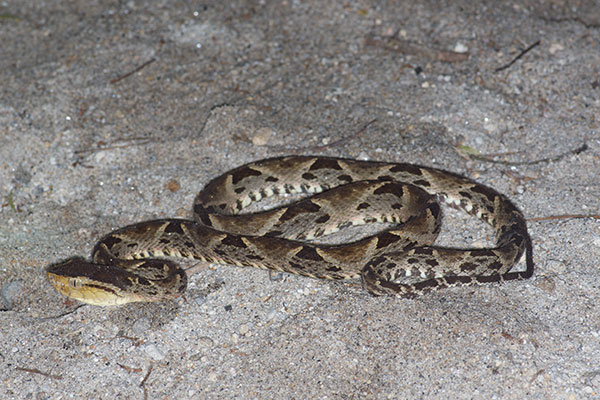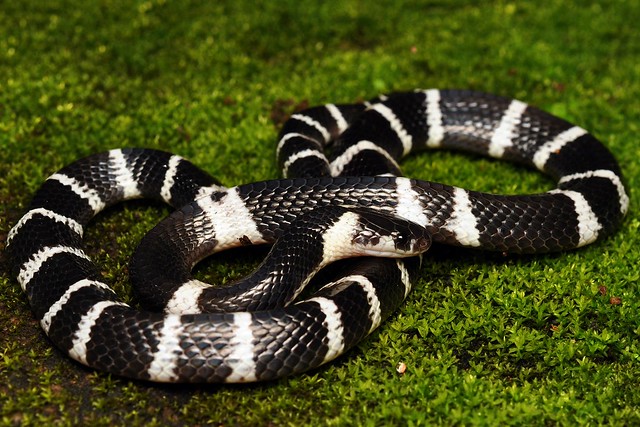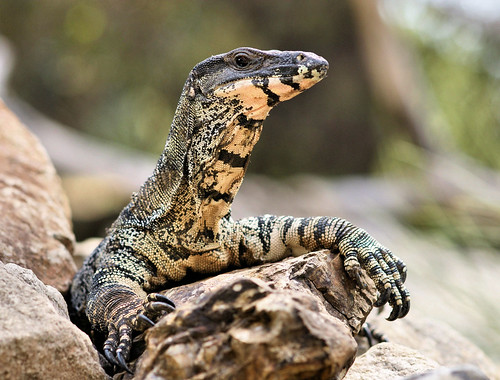Post by Reticulatus on Mar 11, 2014 6:49:06 GMT 5
Common Lancehead

A terrestrial species, adults usually grow to a total length 75–125 cm (about 30-50 inches) and are moderately heavy-bodied. Reports of the maximum size are not clear, as this species is often confused with B. asper. Soini (1974) mentioned of a series of 80 specimens collected in northeastern Peru, the largest was a female of 138.8 cm (4.55 ft). The largest specimen measured by Campbell and Lamar (2004) was a female with a total length of 162 cm (5.31 ft).
The scalation includes 23-29 (usually 23-25) rows of dorsal scales at midbody, 169-214 and 177-214 ventral scales in males and females, respectively, 52-86 (usually 75 or fewer) subcaudal scales in males, which are usually divided, and 47-72 subcaudals in females. On the head, the rostral scale is about as high, or slightly higher, than it is wide. There are three to 11 (usually five to 9) keeled intersupraocular scales, seven to 13 (usually eight to 11) sublabial scales and six to 9 (usually seven) supralabial scales, the second of which is fused with the prelacunal to form a lacunolabial.
The color pattern is highly variable, including a ground color that may be olive, brown, tan, gray, yellow, or (rarely) rusty. The body markings are highly variable, as is the degree of contrast: in some specimens the pattern is very well defined, while in others it may be virtually absent. In general, however, the body pattern consists of a series of dorsolateral blotches, rectangular or trapezoidal in shape, which extend from the first scale row to the middle of the back. These blotches may oppose or alternate across the midline, often fusing to form bands. They also have pale borders, which in some cases may be prominent, and may be invaded from below by tan or gray pigment, occasionally dividing them into pairs of ventrolateral spots. The belly may be white, cream or yellowish gray, with an increasing amount of gray to black mottling posteriorly that may fade again under the tail. The head usually does not have any markings other than a moderately wide postocular stripe that runs from behind the eye back to the angle of the mouth. The iris is gold or bronze, with varying amounts of black reticulation, while the tongue is black.
Their venom consists mostly of hemotoxins. They are much feared because their venom is particularly lethal and fast acting. Presently, treatment is usually possible if the victim receives medical attention soon enough. Commonly, bites from this snake cause symptoms including nausea, blackouts, and paralysis. In almost all cases, temporary and sometimes permanent loss of local or 'short term' memory were reported. Extended hospital stays, as well as weight loss of up to 15 pounds, have also been reported. Venom yield averages 124 milligrams (1.91 gr), although it may be as much as 342 milligrams (5.28 gr). The enzyme reptilase (batroxobin), derived from this snake's venom, is used in modern medical laboratories to measure fibrinogen levels and blood coagulation capability. The test is considered to be a replacement for thrombin time, and is used when heparin is present in the sample. The enzyme is unaffected by heparin.
Common Krait

The average length is 0.9 m (3.0 ft), but they can grow to 1.75 m (5 ft 9 in). Males are longer, with proportionately longer tails. The head is flat and the neck hardly evident. The body is cylindrical, tapering towards the tail. The tail is short and rounded. The eyes are rather small, with rounded pupils, indistinguishable in life. The head shields are normal, with no loreals; four shields occur along the margin of the lower lip; the third and fourth supraoculars touch the eye. The scales are highly polished, in 15-17 rows; the vertebral row is distinctly enlarged and hexagonal. Ventrals number 185-225 and caudals 37-50, entire.
Colouration is generally black or bluish black, with about 40 thin, white crossbars which may be indistinct or absent anteriorly. The pattern, however, is complete and well defined in the young, which are marked with conspicuous crossbars even anteriorly; in old individuals, the narrow white lines may be found as a series of connected spots, with a prominent spot on the vertebral region. A white preocular spot may be present; the upper lips and the belly are white.
The common krait's venom consists mostly of powerful neurotoxins, which induce muscle paralysis. Clinically, its venom contains presynaptic and postsynaptic neurotoxins, which generally affect the nerve endings near the synaptic cleft of the brain.
In mice, the LD50 values of its venom are 0.365 mg/kg SC, 0.169 mg/kg IV and 0.089 mg/kg IP. and the average venom yield is 10 mg (dry weight).
Kraits are nocturnal, so seldom encounter humans during daylight hours; incidents occur mainly at night. Frequently, little or no pain occurs from a krait bite, and this can provide false reassurance to the victim. Typically, victims complain of severe abdominal cramps, accompanied by progressive paralysis. Once bitten, the absorption of the venom into the victim can be considerably delayed by applying a pressure bandage to the bite site (using about the same tension as one uses for a sprained ankle) and immobilising the area. This allows for gentle transport to medical facilities, where the venom can be treated when the bandage is removed. As no local symptoms present, a patient should be carefully observed for signs of paralysis (e.g., the onset of ptosis) and treated urgently with antivenom. It is also possible to support bite victims by mechanical ventilation, using equipment of the type generally available at hospitals. Such support should be provided until the venom is metabolised and the victim can breathe unaided. If death occurs, it takes place about four to eight hours after the krait bite. Cause of death is general respiratory failure, i.e. suffocation.













